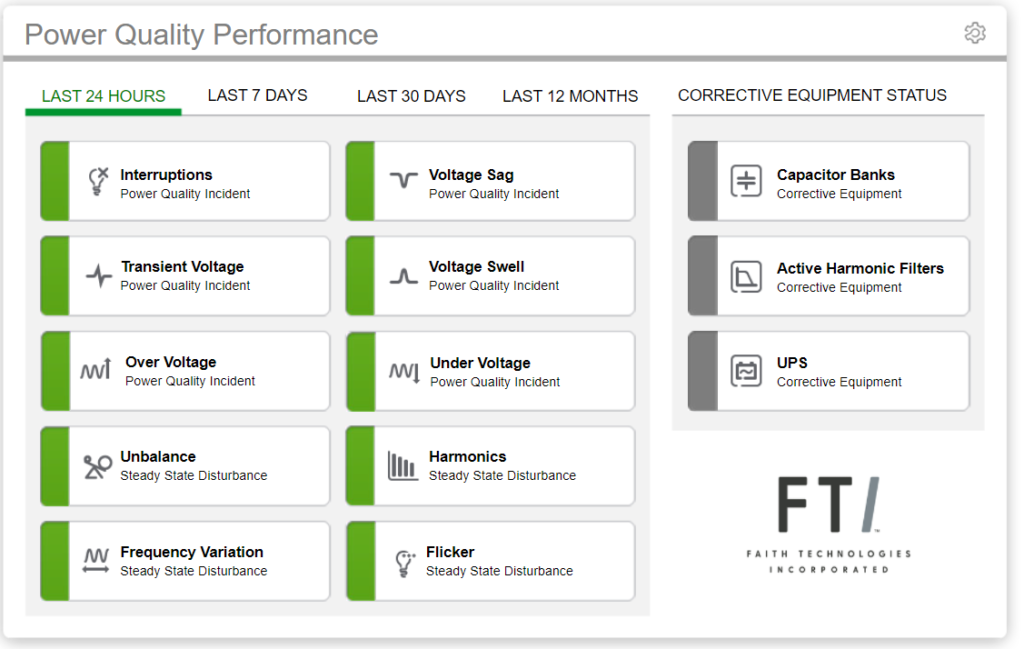12.07.2021
Considerations for Power Quality in Your Facility
When designing a facility, it is commonplace to ensure there will be adequate power. Incorporating equipment to ensure system power quality is stable for the life of the facility may sometimes be overlooked. Often facilities and equipment are updated without revisiting the effects updates may have on the health of the power system. Poor power quality can become a silent killer of electronics, causing unscheduled equipment downtime and damage to devices.
Under ideal conditions, the voltage and current waveforms for an AC source should be a clean sine wave. Unfortunately, that is often not the case. Typical power quality issues that we see on our clients’ electrical systems include:
- Voltage Sags or Swells – where the voltage level changes, usually due to large equipment turning on or off. Length can be a fraction of a cycle to 1 minute. (Think about room lights when you turn on an old vacuum cleaner.)
- Under or Over Voltage – when the voltage is consistently high or low for greater than one minute. (Sometimes caused by improperly tapped transformers, storms, or vegetation on power lines.)
- Voltage and Current Harmonic Distortion – caused by DC power supplies, computer equipment, LED lighting, AC, DC or servo drives, or other non-linear loads in manufacturing and HVAC equipment.
- Unbalanced Loads – where the voltage and current amplitudes are inconsistent or unstable. (Think of a motor with a bearing that intermittently sticks and the load changes.)
 Equipment and industries continue to rely more heavily on complex electronics to maximize efficiency. Because these electronics are designed to work with clean power, poor power quality can lead to excessive heat in motors, transformers and other electrical devices that will shorten equipment life. Power quality issues can also damage capacitors in electronics, causing failure in drives, office equipment and LED light fixtures, or causing equipment to turn off for no apparent reason when voltage levels become unstable.
Equipment and industries continue to rely more heavily on complex electronics to maximize efficiency. Because these electronics are designed to work with clean power, poor power quality can lead to excessive heat in motors, transformers and other electrical devices that will shorten equipment life. Power quality issues can also damage capacitors in electronics, causing failure in drives, office equipment and LED light fixtures, or causing equipment to turn off for no apparent reason when voltage levels become unstable.
To prevent these issues, new facilities usually are designed with:
- 3% or 5% line reactors (or equivalent) on AC, DC and servo drives to limit the generated harmonics.
- A power quality meter (like a Schneider PM8000 series) at the utility entrance for each service. This allows a facility operations team to monitor and alarm for power quality issues. It also can help a facility determine if the poor power quality is caused by their equipment or is from the utility line.
- Detuned or filtered capacitor banks to address power factor needs while avoiding the amplification (or resonance) of harmonics in the system that standard capacitors can cause.
- Isolation transformers or UPS systems for highly sensitive or noisy equipment.
- Active harmonic filtering (such as a Schneider Accusine PCS+ unit), if the previous solutions still allow for excessive harmonic distortion. This is an advanced piece of electrical hardware that actively measures the electrical characteristics of a circuit and works to mitigate poor power quality. It does this by injecting current into the system at a waveform directly opposite that of the poor power quality, canceling the harmonic distortion and correcting the power factor in the process (Think of noise-canceling headphones.)
Many clients we work with have a facility that was designed before these engineering best practices were commonplace. Because capital dollars must always be justified for updates, existing facilities should have a power quality study completed by an experienced provider. The information from these studies can be used to cost-justify system updates such as the following:
- Line reactors – especially for larger drives.
- Permanently installed power quality metering to track progress and diagnose whether problems are from inside or outside the facility grid. This in concert with a monitoring system (such as Schneider Power Monitoring Expert) that notifies users of issues can be very beneficial.
- Changing legacy capacitor banks for detuned or filtered options.
- Adding other equipment to mitigate power quality needs in certain locations of the facility.
At Faith Technologies, we provide our customers with technical solutions that drive results. A power quality study can help customers reduce costs, prevent downtime and plan for the future. How can we support your facility needs?
If you enjoyed this blog article, please subscribe to stay up to date on the latest industry news from our experts at Faith Technologies.



